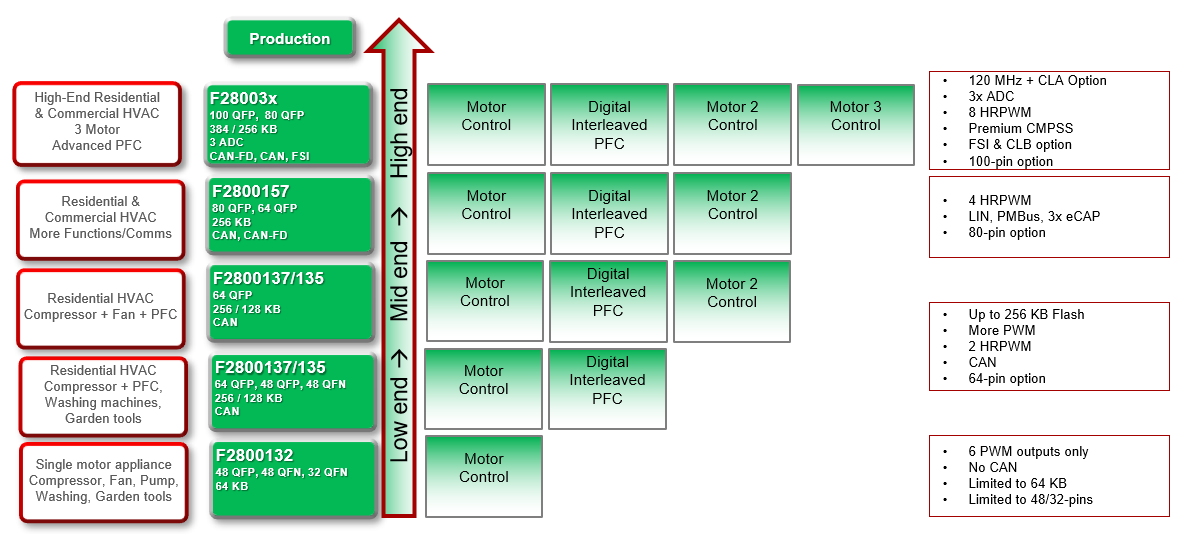SPRADI6 May 2024 F29H850TU , F29H859TU-Q1 , TMS320F2800132 , TMS320F2800133 , TMS320F2800135 , TMS320F2800137 , TMS320F2800152-Q1 , TMS320F2800153-Q1 , TMS320F2800154-Q1 , TMS320F2800155 , TMS320F2800155-Q1 , TMS320F2800156-Q1 , TMS320F2800157 , TMS320F2800157-Q1 , TMS320F28P650DH , TMS320F28P650DK , TMS320F28P650SH , TMS320F28P650SK , TMS320F28P659DH-Q1 , TMS320F28P659DK-Q1 , TMS320F28P659SH-Q1
2 Overview of C2000™ MCU Devices in Appliances
In the realm of appliance systems, the required MCU computing power, memory and resources differ for different functionalities. TI's C2000 MCU series products, ranging from the entry-level 32-pin 64KB Flash F280013x to the 256-pin 1.28MB Flash F28P65x, cover nearly all MCU application needs in appliance systems. Additionally, F280015x has a lock step for the safety requirement. The detailed C2000 MCU resources comparison for both entry-level and performance-level in appliance applications is found in the Implementing IEC 60730 / UL 1998 Compliance for C2000 Real-Time Microcontrollers user's guide.
The C28x core of the third-generation C2000 MCU, is equipped with a Floating-point Unit (FPU), enabling fast floating-point operations, while the TMU supports rapid trigonometric function calculations. Compared to the Arm® Cortex®-M7 core, the frequency of the C28x core is equivalent to twice the frequency capability of the corresponding Arm core due to optimized pipeline structure. With F280013x as an example, the 120MHz frequency capability is equivalent to that of a 240MHz Arm core.
The ePWM module in the C2000 MCU boasts comprehensive and mature function configurations, supporting high-precision PWM modes to deliver accurate and reliable drive control signals. Additionally, all C2000 MCUs come with multiple independent ADC modules, allowing for synchronous sampling to enhanced sampling speed. The built-in comparators can be easily configured to protect AD signals, with protection thresholds set by the internal DAC, providing quick, sensitive, and reliable protection function.
The Real-time Benchmarks Showcasing C2000™ Control MCU's Optimized Signal Chain application note describes a real-time benchmark created around a real-world control application that highlights the intricacies of real-time control and the need for this more comprehensive benchmarking approach.
When selecting a C2000 MCU based on system functionalities, look at the example of an outdoor air conditioning unit. The MCU selection primarily revolves around the basic control requirements of the driver board, which can be categorized as follows: single motor control, single motor + digital PFC control, dual motor + digital PFC control, and triple motor + PFC control.
 Figure 2-1 Select C2000™ MCU Based on System Control
Requirements
Figure 2-1 Select C2000™ MCU Based on System Control
RequirementsIn the TIDA-010265 reference design for single-motor control, a self-test program that meets the requirements of IEC/UL 60730-1 is added to the software, which is found in C2000Ware_MotorControl_SDK_x_0x_00_00\solutions\tida_010265_wminv.